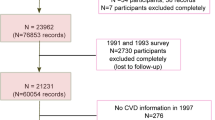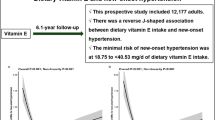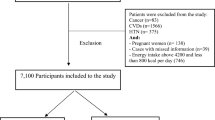Abstract
Background/Objectives:
An understanding of the relationships between dietary habits and supplement use or smoking is useful for aetiological studies and surveillance purposes. The objective of this study is to describe dietary patterns associated with vitamin/mineral supplement use and smoking habits in French women.
Methods:
Scores for dietary patterns were obtained by factor analysis in 64 252 women from the French E3N–EPIC cohort. The association with supplement and tobacco use was investigated by logistic regression analysis.
Results:
We identified three dietary patterns: ‘processed meat/starchy foods’ (fast foods, processed meat, rice/pasta/semolina and cakes and few vegetables); ‘fruit/vegetables’ (fruits, vegetables, seafood, vegetable oils and yoghurt); and ‘alcohol/meat products’ (alcohol, meat and meat products, and coffee, and few fruits and soup). Supplement use was positively associated with the fruit/vegetables pattern (multivariate OR for quartile 4 versus 1 (OR4)=1.55, 95% confidence interval: 1.47–1.63), and inversely associated with the processed meat/starchy foods (OR4=0.84; 0.80–0.89) and alcohol/meat products (OR4=0.69; 0.66–0.73) patterns (P trend for all associations <0.0001). As compared with never smoking, current smoking was inversely associated with the fruit/vegetables pattern (OR4=0.85; 0.78–0.92), while former smoking was positively associated with the fruit/vegetables pattern (OR4=1.32; 1.25–1.40); both current and former smoking were inversely associated with the processed meat/starchy foods pattern (OR4=0.57; 0.53–0.62 and 0.64; 0.60–0.67, respectively); whereas current and former smoking were both strongly positively associated with the alcohol/meat products pattern (OR4=5.78; 5.26–6.36 and 2.03; 1.91–2.15, respectively); P trend for all associations was <0.001.
Conclusions:
Supplement use and smoking are strongly associated with dietary patterns.
This is a preview of subscription content, access via your institution
Access options
Subscribe to this journal
Receive 12 print issues and online access
$259.00 per year
only $21.58 per issue
Buy this article
- Purchase on Springer Link
- Instant access to full article PDF
Prices may be subject to local taxes which are calculated during checkout
Similar content being viewed by others
References
Ainsworth BE, Haskell WL, Whitt MC, Irwin ML, Swartz AM, Strath SJ et al. (2000). Compendium of physical activities: an update of activity codes and MET intensities. Med Sci Sports Exerc 32, S498–S504.
Bamia C, Orfanos P, Ferrari P, Overvad K, Hundborg HH, Tjonneland A et al. (2005). Dietary patterns among older Europeans: the EPIC-Elderly study. Br J Nutr 94, 100–113.
Beer-Borst S, Hercberg S, Morabia A, Bernstein MS, Galan P, Galasso R et al. (2000). Dietary patterns in six European populations: results from EURALIM, a collaborative European data harmonization and information campaign. Eur J Clin Nutr 54, 253–262.
Beitz R, Mensink GB, Hintzpeter B, Fischer B, Erbersdobler HF (2004). Do users of dietary supplements differ from nonusers in their food consumption? Eur J Epidemiol 19, 335–341.
Bjelakovic G, Nikolova D, Simonetti RG, Gluud C (2004). Antioxidant supplements for prevention of gastrointestinal cancers: a systematic review and meta-analysis. Lancet 364, 1219–1228.
Borland SE, Robinson SM, Crozier SR, Inskip HM (2007). Stability of dietary patterns in young women over a 2-year period. Eur J Clin Nutr [E-pub ahead of print].
Cattell RB (1966). The scree test for the number of factors. Multivariate Behav Res 1, 245–276.
Clavel-Chapelon F, van Liere MJ, Giubout C, Niravong MY, Goulard H, Le Corre C et al. (1997). E3N, a French cohort study on cancer risk factors. E3N Group. Etude Epidemiologique aupres de femmes de l'Education Nationale. Eur J Cancer Prev 6, 473–478.
Crozier SR, Robinson SM, Borland SE, Inskip HM (2006). Dietary patterns in the Southampton Women's Survey. Eur J Clin Nutr 60, 1391–1399.
Edwards R (2004). The problem of tobacco smoking. BMJ 328, 217–219.
Engeset D, Alsaker E, Ciampi A, Lund E (2005). Dietary patterns and lifestyle factors in the Norwegian EPIC cohort: the Norwegian Women and Cancer (NOWAC) study. Eur J Clin Nutr 59, 675–684.
FAO/WHO/UNO (1986). Report of a joint expert consultation. Energy and protein requirements. WHO Technical Report Series No. 724: Geneva.
Favier JC, Ireland-Ripert J, Toque C, Feinberg M (1995). Répertoire Général Des Aliments. Tec&Doc ed: Paris.
Guilbert P, Perrin-Escalon H (2004). Baromètre Santé Nutrition 2002. INPES: Saint-Denis.
Harrison RA, Holt D, Pattison DJ, Elton PJ (2004). Are those in need taking dietary supplements? A survey of 21 923 adults. Br J Nutr 91, 617–623.
Hebert JR, Kabat GC (1991). Implications for cancer epidemiology of differences in dietary intake associated with alcohol consumption. Nutr Cancer 15, 107–119.
Hu FB (2002). Dietary pattern analysis: a new direction in nutritional epidemiology. Curr Opin Lipidol 13, 3–9.
Jacobs Jr DR, Steffen LM (2003). Nutrients, foods, and dietary patterns as exposures in research: a framework for food synergy. Am J Clin Nutr 78, 508S–513S.
Jacques PF, Tucker KL (2001). Are dietary patterns useful for understanding the role of diet in chronic disease? Am J Clin Nutr 73, 1–2.
Kerver JM, Yang EJ, Bianchi L, Song WO (2003). Dietary patterns associated with risk factors for cardiovascular disease in healthy US adults. Am J Clin Nutr 78, 1103–1110.
Kesse E, Clavel-Chapelon F, Boutron-Ruault MC (2006). Dietary patterns and risk of colorectal tumors: a cohort of French women of the National Education System (E3N). Am J Epidemiol 164, 1085–1093.
Kesse E, Clavel-Chapelon F, Slimani N, van Liere M (2001). Do eating habits differ according to alcohol consumption? Results of a study of the French cohort of the European Prospective Investigation into Cancer and Nutrition (E3N–EPIC). Am J Clin Nutr 74, 322–327.
Knudsen VK, Rasmussen LB, Haraldsdottir J, Ovesen L, Bulow I, Knudsen N et al. (2002). Use of dietary supplements in Denmark is associated with health and former smoking. Public Health Nutr 5, 463–468.
Lucas F, Niravong M, Villeminot S, Kaaks R, Clavel-Chapelon F et al. (1995). Estimation of food portion size using photographs: validity, strengths, weaknesses and recommendations. J Hum Nutr Diet 8, 65–74.
Lyle BJ, Mares-Perlman JA, Klein BE, Klein R, Greger JL (1998). Supplement users differ from nonusers in demographic, lifestyle, dietary and health characteristics. J Nutr 128, 2355–2362.
Marques-Vidal P, Arveiler D, Evans A, Montaye M, Ruidavets JB, Haas B et al. (2000). Characteristics of male vitamin supplement users aged 50–59 years in France and northern Ireland: the PRIME study. Prospective epidemiological study of myocardial infarction. Int J Vitam Nutr Res 70, 102–109.
Martin A, Azaïs-Braesco V, Bresson JL, Couet C, Cynober L, Guéguen L et al. (2001). Nutritional recommendations for the French population. Sci Aliments 21, 309–458.
Martinez ME, Marshall JR, Sechrest L (1998). Invited commentary: factor analysis and the search for objectivity. Am J Epidemiol 148, 17–19.
McNaughton SA, Mishra GD, Stephen AM, Wadsworth ME (2007). Dietary patterns throughout adult life are associated with body mass index, waist circumference, blood pressure, and red cell folate. J Nutr 137, 99–105.
Messerer M, Johansson SE, Wolk A (2001). Sociodemographic and health behaviour factors among dietary supplement and natural remedy users. Eur J Clin Nutr 55, 1104–1110.
Neuhouser ML, Kristal AR, Patterson RE, Goodman PJ, Thompson IM (2001). Dietary supplement use in the Prostate Cancer Prevention Trial: implications for prevention trials. Nutr Cancer 39, 12–18.
Newby PK, Weismayer C, Akesson A, Tucker KL, Wolk A (2006). Long-term stability of food patterns identified by use of factor analysis among Swedish women. J Nutr 136, 626–633.
Nissen SB, Tjonneland A, Stripp C, Olsen A, Christensen J, Overvad K et al. (2003). Intake of vitamins A, C, and E from diet and supplements and breast cancer in postmenopausal women. Cancer Causes Control 14, 695–704.
Patterson RE, Neuhouser ML, White E, Hunt JR, Kristal AR (1998). Cancer-related behavior of vitamin supplement users. Cancer Epidemiol Biomarkers Prev 7, 79–81.
Patterson RE, White E, Kristal AR, Neuhouser ML, Potter JD (1997). Vitamin supplements and cancer risk: the epidemiologic evidence. Cancer Causes Control 8, 786–802.
Perrin AE, Dallongeville J, Ducimetiere P, Ruidavets JB, Schlienger JL, Arveiler D et al. (2005). Interactions between traditional regional determinants and socio-economic status on dietary patterns in a sample of French men. Br J Nutr 93, 109–114.
Pryer JA, Cook A, Shetty P (2001). Identification of groups who report similar patterns of diet among a representative national sample of British adults aged 65 years of age or more. Public Health Nutr 4, 787–795.
Radimer K, Bindewald B, Hughes J, Ervin B, Swanson C, Picciano MF (2004). Dietary supplement use by US adults: data from the National Health and Nutrition Examination Survey, 1999–2000. Am J Epidemiol 160, 339–349.
Riboli E (1992). Nutrition and cancer: background and rationale of the European Prospective Investigation into Cancer and Nutrition (EPIC). Ann Oncol 3, 783–791.
Riccioni G, Bucciarelli T, Mancini B, Di Ilio C, Capra V, D'Orazio N (2007). The role of the antioxidant vitamin supplementation in the prevention of cardiovascular diseases. Expert Opin Investig Drugs 16, 25–32.
Rock CL (2007). Multivitamin–multimineral supplements: who uses them? Am J Clin Nutr 85, 277S–279S.
Scali J, Richard A, Gerber M (2001). Diet profiles in a population sample from Mediterranean southern France. Public Health Nutr 4, 173–182.
Schulze MB, Hoffmann K, Kroke A, Boeing H (2001). Dietary patterns and their association with food and nutrient intake in the European Prospective Investigation into Cancer and Nutrition (EPIC)—Potsdam study. Br J Nutr 85, 363–373.
Slattery ML, Boucher KM, Caan BJ, Potter JD, Ma KN (1998). Eating patterns and risk of colon cancer. Am J Epidemiol 148, 4–16.
Terry P, Suzuki R, Hu FB, Wolk A (2001). A prospective study of major dietary patterns and the risk of breast cancer. Cancer Epidemiol Biomarkers Prev 10, 1281–1285.
Touvier M, Kesse E, Clavel-Chapelon F, Boutron-Ruault MC (2005). Dual Association of beta-carotene with risk of tobacco-related cancers in a cohort of French women. J Natl Cancer Inst 97, 1338–1344.
Touvier M, Kesse E, Volatier JL, Clavel-Chapelon F, Boutron-Ruault MC (2006). Dietary and cancer-related behaviors of vitamin/mineral dietary supplement users in a large cohort of French women. Eur J Nutr 45, 205–214.
van Liere MJ, Lucas F, Clavel F, Slimani N, Villeminot S (1997). Relative validity and reproducibility of a French dietary history questionnaire. Int J Epidemiol 26 (Suppl 1), S128–S136.
Zondervan KT, Ocke MC, Smit HA, Seidell JC (1996). Do dietary and supplementary intakes of antioxidants differ with smoking status? Int J Epidemiol 25, 70–79.
Acknowledgements
We are indebted to all participants for providing the data. We are grateful to Lyan Hoang and Marie Fangon for their technical assistance; to all members of the E3N group; and to Catriona Holmes and Jerri Bram for their assistance with English editing. This study was supported by the French Food Safety Agency, the French League against Cancer, the European Community, the 3M Company, the Mutuelle Générale de l'Education Nationale, the Institut Gustave Roussy and the Institut National de la Santé et de la Recherche Médicale.
Author information
Authors and Affiliations
Corresponding author
Additional information
Contributors: MT designed the study, analysed and interpreted the data and wrote the manuscript. MN was in charge of collection and validation of dietary data. J-LV, LL and SL contributed in interpreting results and editing the manuscript. FC designed and coordinated the study cohort and supervised the study. MCBR supervised the design, analysis and interpretation of the data, as well as writing of the manuscript. All authors reviewed the manuscript. None of the authors had a conflict of interest.
Appendix
Rights and permissions
About this article
Cite this article
Touvier, M., Niravong, M., Volatier, JL. et al. Dietary patterns associated with vitamin/mineral supplement use and smoking among women of the E3N–EPIC cohort. Eur J Clin Nutr 63, 39–47 (2009). https://doi.org/10.1038/sj.ejcn.1602907
Received:
Revised:
Accepted:
Published:
Issue Date:
DOI: https://doi.org/10.1038/sj.ejcn.1602907
Keywords
This article is cited by
-
Dietary supplements increase the risk of excessive micronutrient intakes in Danish children
European Journal of Nutrition (2023)
-
Quantitative assessment of dietary supplement intake in 77,000 French adults: impact on nutritional intake inadequacy and excessive intake
European Journal of Nutrition (2019)
-
Faut-il prendre plus de 110 mg de vitamine C par jour ?
Phytothérapie (2014)
-
Concurrent Use of Drugs and Supplements in a Community-Dwelling Population Aged 50 Years or More: Potential Benefits and Risks
Drugs & Aging (2014)
-
Smoking and dietary inadequacy among Inuvialuit women of child bearing age in the Northwest Territories, Canada
Nutrition Journal (2013)



